Archived Storm Damage Blog Posts
How to Repair Storm Damage to Your Home
2/2/2023 (Permalink)
Whether you're a homeowner, renter, or condo dweller, it's important to know how to deal with storm damage. Storms can cause severe damage to homes and make it harder for people to get back on their feet in their own homes after a disaster. This guide will help you prepare before storms hit and help you repair your home if there is damage after the storm passes.
Prepare for the Worst
The first step to recovery is preparation. Here are some tips to get you started:
Make a list of important documents, such as your insurance policy, medical records, and bank account information. Keep this list in a safe place just in case you need it later on. You can also store digital copies of these documents somewhere offsite if you have them on your computer or phone.
If you live in an area prone to flooding or storm damage, contact your insurance company and let them know where you are located. This will help ensure that they understand the risks associated with insuring someone who lives in such an area and can adjust their rates accordingly when necessary.
Store an emergency supply kit near your main exit point from the house so that it's easy to grab when needed (e.g., during storms). The contents of this kit should include water purification tablets/drop neutralizers, food rations sufficient for three days (including non-perishable items), canned goods for two weeks worth of meals (including meat), toiletries (toothbrush/paste etc.), clothing suitable for warm weather conditions (i.e., tank tops/shorts)
Evaluate the Damage and Document It
After the storm is over, you will want to quickly assess the damage. Start by documenting all of the damage with pictures. After you've documented the damage in detail and photographed it (with your camera or smartphone), make sure you keep copies of these images stored on a flash drive or other secure electronic storage device. This way, if there's ever an issue with your insurance claim you will have proof of the damage. They may need documentation of what happened within those first few days after the storm passed through your area and you want to make sure you have that readily available.
Cut Off the Power
If you have a home generator, turn it off at the main switch and make sure all gas lines are shut off. If you have an emergency power system, ensure that it is not connected to the grid by turning off the circuit breaker for your house and checking that no electrical panels are attached. Shutting off power can be dangerous because of the risk of electrocution or fire from electrical appliances. Therefore, it is important only to do so if a qualified professional recommends it or after giving yourself plenty of time to do so safely.
After turning off power in your home, check for potential hazards such as gas leaks (use a flashlight) and fire hazards (remove flammables). You may need to call emergency services if any such hazards exist before proceeding with repairs on your property.
If you suspect there has been damage due to high winds or other weather-related events like tornadoes or hurricanes, refrain from using any electrical appliances until they have been inspected by a licensed electrician
Contact Your Insurance Company
Your policy should tell you how to contact your insurance company, so be sure to have a copy of it on hand before you call. They will want to know what happened and how much the estimated damage is. Make sure they know that there could be additional costs if the storm caused flooding or other damage outside of what was immediately visible like broken windows or roof shingles coming off. If you aren't insured, then there's no reason for them to make any payments towards repairs because they won't get paid back by any third party (like the government). If this is the case, then expect that any expenses associated with fixing up your home will fall entirely on you!
Clean Up
Here are some tips to starting the cleanup process:
1. Remove any damaged furniture or belongings from your home.
2. Clean up any broken glass in the areas affected by flooding or severe hail and wind.
3. Make sure there are no exposed electrical wires before you begin cleaning up water and mud/dirt. If there is, shut off all power to the area where they are found and call an electrician immediately! Even if you don't know what circuit breaker turns off this particular switch, it's better to be safe than sorry when dealing with electricity!
4. Remove hazardous materials like chemicals, pesticides, oil-based paints or cleaners (as they may contain asbestos), gasoline/diesel fuel from tanks on boats/cars (as these can leak into groundwater), etc., as soon as possible by contacting a disposal company.
Dry it Out
You can use fans and dehumidifiers to start the drying process in your home. In most cases, if the damage is extensive, it is a good idea to call a professional like SERVPRO of Fresno Northeast/Shaver Lake to get your Hendersonville, NC home dry.
Repair or Replace?
A contractor will help you determine if the damage is something that can be repaired or replaced. If you have the skills and equipment, you may be able to do this yourself. You may need to hire a contractor if the damage is extensive and/or complicated in nature. Again, SERVPRO of Fresno Northeast/Shaver Lake can help with this process!
It doesn't matter what season it is or where you live—disasters can happen at any moment and can be caused by natural or human-made occurrences. No matter what kind of storm hits your home, safety should always be the first priority for everyone involved. If a storm comes through your area and causes damage to your home (or any other building), make sure that everyone stays safe until the danger has passed, and contact local authorities about getting repairs done as soon as possible.
These steps can help you get back on track after a storm, but if you’re in doubt about any of them, don’t hesitate to call your insurance company. Their experts can guide you through the process so that you can focus on recovery instead of worrying about paperwork or repairs.
Storm-Damaged Home in Fresno County?
6/14/2022 (Permalink)
SERVPRO of Clovis has been restoring storm damage in Clovis for many years. Storms often blow in with little or no advanced warning, causing wind and rain damage. March is one of the rainier months of the year in Clovis. If you haven’t already, now is a good time to inspect your home to ensure water can not enter your home during the next storm.
A drone can be used to fly over your home to check for damaged roof tiles or shingles, and it will also show you where your rain gutters are clogged.
Check your downspouts to make sure they are pointed away from your home’s foundation and that there are no barriers that would cause water to pool around your home’s foundation.
Call Us Today!
You never know when the next big storm will wreak havoc on your home or commercial business. If you have a storm damage emergency, SERVPRO of Clovis is Here to Help. ® Our technicians are on-call 24-hours a day to serve you. Call us today at 559-297-3429.
Franchises are independently owned and operated.
Restoring Desired Moisture Levels in Flood-Damaged Clovis Homes
6/10/2022 (Permalink)
Flooding Can Leave Many Structural Elements in Clovis Properties Saturated and in Need of Moisture Removal.
Flooding can be more common to Clovis homes and businesses than you might think. With many exposed contents and structural elements, many look to the professionals of our SERVPRO team to help. Effective drying of flooded spaces involves restoring desired moisture levels within flood-damaged properties, including specific relative humidity percentages required for individual building materials.
Moisture Detection Devices
Visual inspection is only part of the process for identifying flood damage to Clovis properties. Technicians rely on moisture detection devices to gain perspective on the depth of the damage and how the migration of water extends beyond the surface layer. Likewise, an initial moisture inspection determines affected assemblies and the edge of the water-damaged area.
Determining the Desired Moisture Levels
All drying efforts are designed around the nature of water damage to seek equilibrium. When met with the ideal relative humidity and temperature, materials can reach a point in which they do not intake nor expel moisture. Achieving this balance is critical for the restoration of specific materials and zones, including:
- Wood flooring
- Carpets
- Drywall
- Environmental humidity
Preventing Mold and Microbial Growth
Flood damage can be even more alarming when you consider the possibilities of mold and microbial growth. The potential contaminants present in natural flooding can act as an amplifier for microbial development in moist environments. Preventing growth involves the application of mold inhibitors and biocide products.
Flood damage can develop rapidly and overwhelm Fresno County homes. Our SERVPRO of Clovis team seeks out the desired moisture content in building materials to efficiently manage flood losses and the damage they can do. Give us a call at (559)297-3429.
Storm Damage in Clovis, CA
6/8/2022 (Permalink)
Storm damage in town due to heavy rains and customer's roof being old, therefore it made the bedroom ceiling collapse. Customer called us to go out and help them tarp the roof from the outside in order to keep water from coming in through the bedroom ceiling. All debris, drywall and insulation was removed and hauled off.
Do you have storm damage?
Everyone knows that any major storm can leave your home with damage. From serious thunderstorms and snowstorms to hurricanes and tornadoes, your major structures like your roof, siding, fencing, outbuildings, and more can be left with a variety of problems that need repair. Wind can topple trees, rain can cause flooding, hail can put dents and holes in the roof and gutters, lightening strikes this can wreak havoc on electrical system. If you're experiencing any of issues, it's time to call SERVPRO Of Clovis for an inspection or damage repair.
Call us! 559-297-3429
Storm/Wind Damage in Clovis, CA
6/8/2022 (Permalink)
This was a storm/wind damage to the owners roof. When a storm hits you must act quickly to help prevent further damage and protect your home’s interior. Without warning, nature can take a violent turn: floods, wildfires, tornadoes, hurricanes, blizzards. Any of these can have a devastating effect on your home or business and you can count on SERVPRO of Clovis to be there for you day or night. Response time is critical, not only to mitigate your damages but to get your home back to normal quickly.
Nevertheless, roof damage needs to be addressed immediately to help avoid further harm by the elements or intruders. Our professional crews use roof tarping and board-up techniques to help keep your home or business secure while the roof is inspected and repaired. Call SERVPRO Of Clovis for any wind, storm or roof damage. 559-297-3429
Call Us!
6/6/2022 (Permalink)
SERVPRO of Clovis understands your situation as a Insurance agent, adjuster or Property Manager. Not only do you have to deal with customers who need help and guidance but it is your responsibility to keep claim cost down while still providing the best services to your customers. You are the main contact for the customer and very important. SERVPRO of Clovis is uniquely qualified to help. From duct cleaning, mold remediation to fire, water and storm damage mitigation we are able to make it look "Like it never even happened." Our results create a measurable difference, showing the customer you care and giving you many competitive advantages, including:
Emergency response, electronic Commerce to provide information and proof of results.
Call SERVPRO of Clovis, the Mitigation Company you can trust. 559-297-3429
SERVPRO of Clovis is ready!
6/6/2022 (Permalink)
Resources to Handle Floods and Storms
When storms hit Fresno County, we can scale our resources to handle a large storm or flooding disaster. We can access equipment and personnel from a network of 2,000 Franchises across the country and elite Disaster Recovery Teams that are strategically located throughout the United States.
Faster Response
Since we are locally owned and operated, we are able to respond quicker with the right resources, which is extremely important. A fast response lessens the damage, limits further damage, and reduces the restoration cost.
“Like it never even happened.”
SERVPRO ofClovis specializes in storm and flood damage restoration. Our crews are highly trained and we use specialized equipment to restore your property to its pre-storm condition.
Have Storm or Flood Damage? Call Us Today (559) 297-3429
How do Professionals Remove Water from Your Flood Damaged Clovis Home?
6/14/2021 (Permalink)
SERVPRO Storm Damage Remediation Can Help Prevent Any Secondary Damages
Whether it is due to a storm, heavy rains or any other natural disaster, a flood can cause extensive damage to your home. The key to a successful restoration after flood damage is quick water removal and preventing secondary damage.
Thankfully, professional restoration experts can take care of your flood damaged Clovis home. SERVPRO technicians can start the mitigation process as soon as we hear from you. The process of flood damage restoration is a multi-step process that can take time and needs expertise. Here are some of the steps that professionals use to remove water after a flood.
Removal of the standing water
The first step is to get the floodwater out of your home. Various equipment can be used to get this job done depending on the amount of water that needs to be removed. If the water is not quickly removed, it can continue to cause corrosion and damage with each passing hour.
The equipment that is used to pump out the standing water is called an extractor. It is used to remove the excess water from the floors, carpets, and upholstery after flood damage. Extractors can be of varying sizes and capacities. While the technicians can use portable extractors for small amounts of water, larger volumes often require truck mounted versions.
Removal of the residual moisture
Even after the standing water is removed, the residual moisture can continue to inflict damage. It is essential to get rid of this residual moisture by drying the contents of the flood-damaged home with proper equipment. The process of eliminating the excess moisture begins with the assessment of the amount of residual moisture remaining. SERVPRO technicians use various moisture testing equipment such as moisture meters and thermohygrometers to ascertain the level of the residual water.
The next step is to eliminate this excess moisture with the help of equipment such as dehumidifiers and air movers. The goal is to create a condition that allows rapid and efficient drying. The technicians establish a drying goal and work toward achieving it as soon as possible.
Call SERVPRO of Clovis today at 559-297-3429 and schedule an appointment if you find yourself dealing with a flooded home on Clovis and we will be there to help throughout the whole mitigation process.
Handling a Flooded Home with Mitigation
6/10/2021 (Permalink)
Having an extensive amount of water in your home or having to deal with water in a business area is difficult to handle on your own. By contacting professionals such as SERVPRO of Clovis, you can save yourself from the stress of many of the issues that come with flooding.
The first step would be to send one of their experts out to look and assess the flood damage that is apparent in your home or business. If you currently have water in the home or any type of water in a business that is standing, they will help to clear this away to begin the restoration process.
If you are experiencing flooding of any kind give us a call at SERVPRO of Clovis ASAP and we will be here to help!
Stay Prepared: Do You Have an Emergency Storm Kit?
6/4/2021 (Permalink)
An storm kit should be in a location in your home that all family members are aware of in case of emergency. SERVPRO of Clovis wants to share some of the following tips to keep in mind while putting together an emergency kit in the event of a severe storm or any other case of emergency approaching. As laid out by FEMA, the following items should be included in your emergency kit:
- Flashlight and extra batteries
- First aid kit
- Any medicine currently being taken
- Emergency food and water
- Extra change of clothes and shoes
- Pet supplies if you are taking care of an animal
These are just a few examples of what an emergency kit should contain. Residents can add whatever else they may need. There should be an emergency kit in every residential building as well as all commercial buildings if possible. Aside from having an emergency kit ready, a plan should also be in place. If there is a designated storm area inside the home or office, occupants should head there with the emergency kits. Severe storms cannot be avoided, but with the right tools and resources they can be easier to deal with.
Disaster Preparedness : Disinfecting Drinking Water
6/2/2021 (Permalink)
 Make sure any water that can possibly be consumed is disinfected as best as possible.
Make sure any water that can possibly be consumed is disinfected as best as possible.
USE ONLY WATER THAT HAS BEEN PROPERLY DISINFECTED FOR DRINKING, COOKING, MAKING ANY PREPARED DRINK, OR FOR BRUSHING TEETH
1. Use bottled water that has not been exposed to any potentially contaminated waters if it is available.
2. If you don’t have bottled water, you should boil water to make it safe. Boiling water will kill most types of disease-causing organisms that may be present. If the water is cloudy, filter it through clean cloths or allow it to settle, and draw off the clear water for boiling. Boil the water for one minute, let it cool, and store it in clean containers with covers.
3. If you can’t boil water, you can disinfect it using household bleach. Bleach will kill some, but not all, types of disease-causing organisms that may be in the water. If the water is cloudy, filter it through clean cloths or allow it to settle, and draw off the clear water for disinfection. Add 1/8 teaspoon (or 8 drops) of regular, unscented, liquid household bleach for each gallon of water, stir it well and let it stand for 30 minutes before you use it. Store disinfected water in clean containers with covers.
4. If you have a well that has been flooded, the water should be tested and disinfected after flood waters recede. If you suspect that your well may be contaminated, contact your local or state health department or agriculture extension agent for specific advice.
Wildfire Preparedness, Keep your Property as Safe as Possible
6/2/2021 (Permalink)
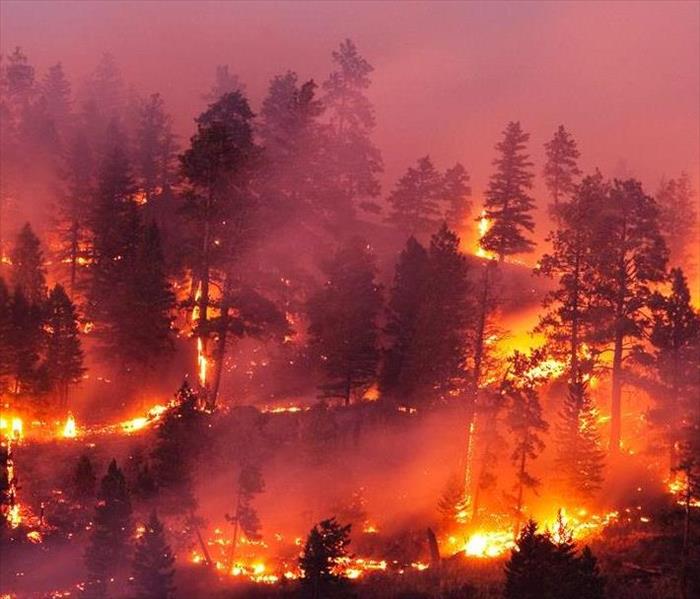 Stay safe this hot summer and prepare your property from wildfires
Stay safe this hot summer and prepare your property from wildfires
The geography, weather patterns and number of Wildland Urban Interface communities in California make it a state particularly threatened by devastating wildfire. Wildfires are more rampant now then they have been in past years, this makes it very important to make sure you are prepared as and take action now to prevent as much damage as possible to your home in the case of a wildfire. As stated by CALFire we must Plan, Prepare, and stay Aware.
Get Ready (create 3 defensible zones around your home)
Zone 0 - this is the first 5ft around your home.
- It is recommended that you remove all dead and dying weeds, grass, plants, shrubs, trees, branches and vegetative debris
- make sure there is no firewood in this zone
- Limit plants in this area to low growing, nonwoody, properly watered and maintained plants
- Limit combustible items (outdoor furniture, planters, etc.) on top of decks
Zone 1 - this is 30ft from buildings structures, decks, etc.
- Relocate wood piles to Zone 2.
- Remove or prune flammable plants and shrubs near windows.
- Remove vegetation and items that could catch fire from around and under decks, balconies and stairs.
Zone 2 - from 30 feet to 100 feet out from buildings, structures, decks, etc. or to your property line, whichever is closer.
- Cut or mow annual grass down to a maximum height of 4 inches.
- Create horizontal space between shrubs and trees. (See diagram)
- Create vertical space between grass, shrubs and trees. (See diagram)
- Remove fallen leaves, needles, twigs, bark, cones, and small branches. However, they may be permitted to a depth of 3 inches.
- All exposed wood piles must have a minimum of 10 feet of clearance, down to bare mineral soil, in all directions.
Other Ways to Prepare for a Wildfire
Being prepared can reduce the amount of loss during a wildfire and potentially save your property from further damage.
Act Fast When Roof Damage is Discovered
6/2/2021 (Permalink)
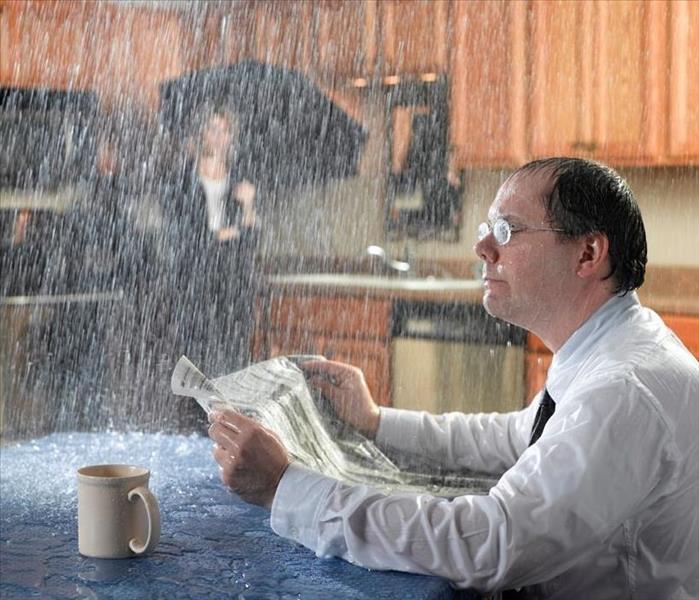 Don't let a small problem become a huge emergency
Don't let a small problem become a huge emergency
Damage to the roof due to harsh weather can be very troublesome and damaging to a home. Many times, you aren’t sure where to start or who to call. One of the best things that you can do is to call your local SERVPRO and roofer to asses the damage. Be wary of any fly-by-night roofing companies that always pop up any time there is a large storm or natural disaster. This will ensure that you get the highest quality service, and results that are in your best interest.
Often roof storm damage is not visible to the naked eye and partnering with a reputable company such as SERVPRO of Clovis who understands the issues is a benefit. If you do find storm damage, let SERVPRO help set you in the right direction. We will tarp your roof to prevent further water damage inside your home. We will then help you come up with a game plan to get your home better than it was before!
Thunderstorm Time
6/3/2020 (Permalink)
A thunderstorm is considered severe if it produces hail at least 1 inch in diameter or has wind gusts of at least 58 miles per hour. Every thunderstorm produces lightning, which kills more people each year than tornadoes or hurricanes. Heavy rain from thunderstorms can cause flash flooding, and high winds can damage homes and blow down trees and utility poles, causing widespread power outages.
Know the Difference
Severe Thunderstorm Watch - Severe thunderstorms are possible in and near the watch area. Stay informed and be ready to act if a severe thunderstorm warning is issued.
Severe Thunderstorm Warning - Severe weather has been reported by spotters or indicated by radar. Warnings indicate imminent danger to life and property.
Every year people are killed or seriously injured by severe thunderstorms despite advance warning. While some did not hear the warning, others heard the warning and did not pay attention to it. The information in this section, combined with timely watches and warnings about severe weather, may help save lives.
Winter Storms
6/2/2020 (Permalink)
Winter storms can range from a moderate snow over a few hours to a blizzard with blinding, wind-driven snow that lasts for several days. Some winter storms are large enough to affect several states, while others affect only a single community. Many winter storms are accompanied by dangerously low temperatures and sometimes by strong winds, icing, sleet and freezing rain.
Regardless of the severity of a winter storm, you should be prepared in order to remain safe during these events.
Know the Difference
Winter Storm Outlook - Winter storm conditions are possible in the next 2 to 5 days.
Winter Weather Advisory - Winter weather conditions are expected to cause significant inconveniences and may be hazardous. When caution is used, these situations should not be life threatening.
Winter Storm Watch - Winter storm conditions are possible within the next 36 to 48 hours. People in a watch area should review their winter storm plans and stay informed about weather conditions.
Winter Storm Warning - Life-threatening, severe winter conditions have begun or will begin within 24 hours. People in a warning area should take precautions immediately.
Trust SERVPRO of Clovis for your restoration needs.
What you can do to help
6/2/2020 (Permalink)
- Increase grade: The earth around the home should be sloped away from the house to divert water away. Very simply, borrow earth from three feet away from the structure, and toss it against the side of the house thus creating the slope.
- Clean rain gutters: Schedule a licensed professional to clean gutters annually. A clogged rain gutter can send water cascading down the exterior wall, which can result in water entering the interior walls.
- Divert down spouts: In a quick run to the local hardware store, homeowners can find a black, plastic corrugated 6-inch hose that fits around the base of the downspout. This device carries water away from the house, preventing it from seeping down into the foundation.
- Roof maintenance: Where rain is concerned, the roof is the first line of defense. One small tear in a rubber membrane or crack in a tin roof, or compromise in the plywood structure of the roof can prove disastrous for the entire interior of the home. But regular maintenance can preserve the life of the roof. Have a roofer check out your home every five years.
- Window repairs: Proper window installation and maintenance is imperative. Modern windows are fitted with wells and drains designed to help direct water outside the house. Improper caulking can prove disastrous by sending water into the house that should be draining away from the window.
- Sweep away debris: Especially during spring and fall seasons, when the area’s great trees emit pollen in tumble weed fashion and drop their leaves in mass, it is critical to diligently sweep outdoor surfaces weekly, especially patios and door wells to prevent the collection of debris clogging exterior drains.
When Storms Hit!
6/2/2020 (Permalink)
SERVPRO of Clovis specializes in storm and flood damage restoration. Our crews are highly trained and we use specialized equipment to restore your property to its pre-storm condition.
Faster Response
Since we are locally owned and operated, we are able to respond quicker with the right resources, which is extremely important. A fast response lessens the damage, limits further damage, and reduces the restoration cost.
Resources to Handle Floods and Storms
When Storms hit weather your in Fresno and Clovis, or in the mountains of Shaver Lake and Bass Lake, we can scale our resources to handle a large storm or flooding disaster. We can access equipment and personnel from a network of 1,650 Franchises across the country and elite Disaster Recovery Teams are strategically located throughout the United States.
Have Storm or Flood Damage? Call SERVPRO of Clovis, 559-297-3429
How to Protect Your Home
6/1/2020 (Permalink)
- Increase grade: The earth around the home should be sloped away from the house to divert water away. Very simply, borrow earth from three feet away from the structure, and toss it against the side of the house thus creating the slope.
- Clean rain gutters: Schedule a licensed professional to clean gutters annually. A clogged rain gutter can send water cascading down the exterior wall, which can result in water entering the interior walls.
- Divert down spouts: In a quick run to the local hardware store, homeowners can find a black, plastic corrugated 6-inch hose that fits around the base of the downspout. This device carries water away from the house, preventing it from seeping down into the foundation.
- Roof maintenance: Where rain is concerned, the roof is the first line of defense. One small tear in a rubber membrane or crack in a tin roof, or compromise in the plywood structure of the roof can prove disastrous for the entire interior of the home. But regular maintenance can preserve the life of the roof. Have a roofer check out your home every five years.
- Window repairs: Proper window installation and maintenance is imperative. Modern windows are fitted with wells and drains designed to help direct water outside the house. Improper caulking can prove disastrous by sending water into the house that should be draining away from the window.
- Sweep away debris: Especially during spring and fall seasons, when the area’s great trees emit pollen in tumble weed fashion and drop their leaves in mass, it is critical to diligently sweep outdoor surfaces weekly, especially patios and door wells to prevent the collection of debris clogging exterior drains.
How to Prepare for a Storm
6/1/2020 (Permalink)
Things to do:
- Winterize your vehicle and keep the gas tank full. A full tank will keep the fuel line from freezing.
- Insulate your home by installing storm windows or covering windows with plastic from the inside to keep cold air out.
- Maintain heating equipment and chimneys by having them cleaned and inspected every year.
- If you will be going away during cold weather, leave the heat on in your home, set to a temperature no lower than 55° F.
SERVPRO of Clovis can handle storm damage to your business or home. Storm are unpredictable and so scary when your home is being affected. You can count on us help help get your home back and feel safe knowing when storms hit we can make it look "Like it never even happened."
If a Flood or Storm Hit SERVPRO of Clovis is Ready!
6/3/2019 (Permalink)
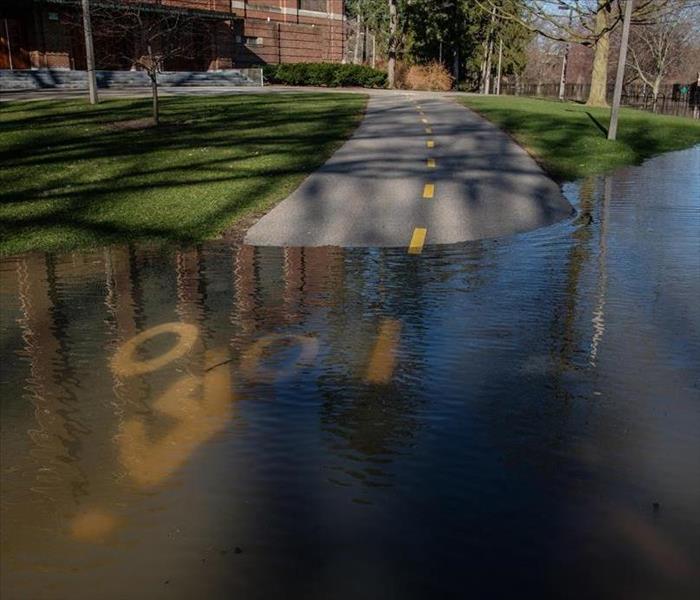 When a flood hits Clovis, SERVPRO of Clovis is ready for action!
When a flood hits Clovis, SERVPRO of Clovis is ready for action!
SERVPRO of Clovis specializes in storm and flood damage restoration. Our crews are highly trained and we use specialized equipment to restore your property to its pre-storm condition.
Faster Response
Since we are locally owned and operated, we are able to respond quicker with the right resources, which is extremely important. A fast response lessens the damage, limits further damage and reduces the restoration cost.
Resources or Handle Floods and Storms
If storms hit Clovis, we can scale our resources to handle a large storm or flooding disaster. We can access equipment and personnel from a network of 1,650 Franchises across the country and elite Disaster Recovery Teams that are strategically located throughout the United States.
Have Storm or Flood Damage? Call Us Today at 559-297-3429
Storm Damage Preparedness
6/3/2019 (Permalink)
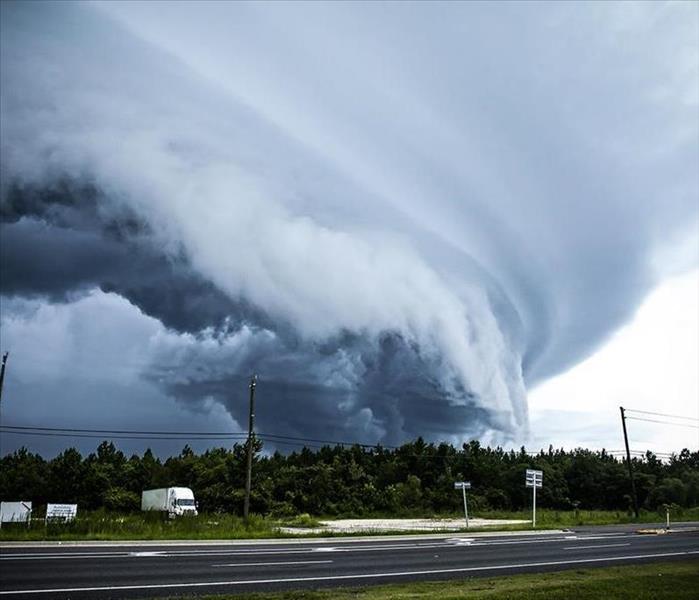 If a storm hits be prepared.
If a storm hits be prepared.
MAKE A PLAN
Water
- Water will keep you alive. If you have enough water, you can live on half of your normal food intake. Make sure to store at least one gallon of water per person per day and store enough water to last two weeks.
- People in hot environments, children, people who are ill and nursing mothers should store more.
- Rotate your water supply every six months
- Other sources of water in your home: water heater, ice cubes, pipes and toilet tank (not the bowl)Unlike water, food can be rationed. Store at least a three to five-day supply of non-perishable food in a dry place where the temperature is not above 70 degrees. PetsBut you should know safe places to keep your pets if you have to evacuate with them. Where are hotels and motels outside of your area that accept pets? What friends or family members could keep them for you? Which boarding facilities, veterinarians or shelters could be used?Your water heater can be a critical source of water in an emergency, but only if it’s still standing. Go to your home improvement store of choice and buy the metal straps to secure the water heater to nearby studs.GasWhen you should shut off your gas meter:
- If you have natural gas coming into your home, it’s easy to turn off, but not so much for turning it back on. Only qualified people should turn gas back on.
- A falling water heater can break gas lines and water lines or spill your water.
- Utilities
- Pets are an important member of your family. Plan for them as well. Remember that emergency shelters typically do not allow animals. Only service animals are allowed in shelters.
- Select foods that require little or no preparation, water or refrigeration. Select foods that are high in calories, nutritious, compact and lightweight. Choose foods your family will eat.
- Food
- You smell natural gas
- You hear gas leaking
- There is a fire (unless shutting off the gas would jeopardize your safety)
- If you need to shut off the gas, use a wrench to turn the valve a quarter turn in either direction
- Take some time to become familiar with which utilities enter your home and where they can be shut off. As you practice emergency plans, locate and map the gas, water and electricity mains. During family drills, go through the movements, but do not practice shutting off gas lines.
Thunderstorm Safety
5/28/2019 (Permalink)
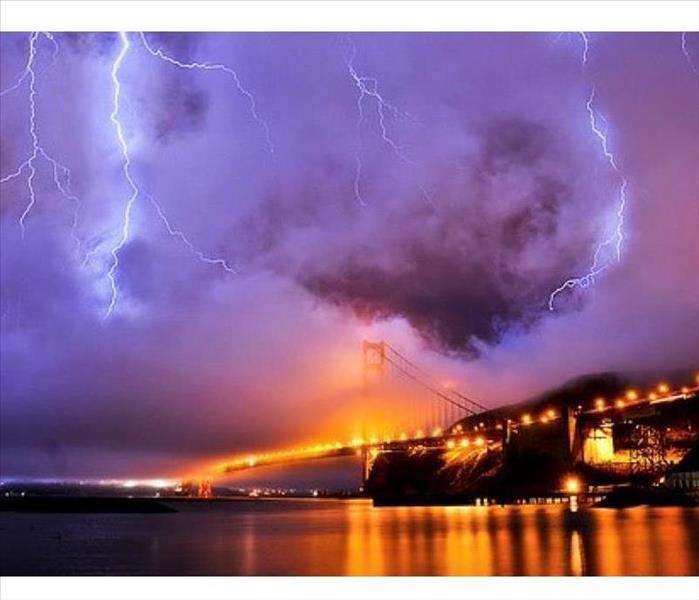 Thunderstorm Safety
Thunderstorm Safety
A thunderstorm is considered severe if it produces wind gusts of at least 58 miles per hour. Every thunderstorm produces lightning, which kills more people each year than tornadoes or hurricanes. Heavy rain from thunderstorms can cause flash flooding, and high winds can damage homes and blow down tree and utility poles - causing widespread power outages.
WATCH vs. WARNING
Watch: Severe thunderstorms are possible in and near the watch area
Warning: Severe weather has been reported by spotters or indicated by radar. Warnings indicate imminent danger to life and property.
Be Prepared
- Learn about your local community’s emergency warning system for severe thunderstorms
- Pick a safe place in your home for household members to gather during a thunderstorm This should be away from windows, skylights and glass doors that could be broken by strong winds or hail
- Make a list of items to bring inside in the event of a severe thunderstorm
- Make trees and shrubbery more wind resistant by keeping them trimmed and removing damaged branches
- Protect your animals by ensuring that any outside buildings that house them are protected in the same way as your home
Make Preparedness Kit
- Water—one gallon per person, per day
- Food—non-perishable, easy-to-prepare
- Flashlight
- Battery-powered or hand-crank radio (NOAA Weather Radio, if possible)
- Extra batteries
- First aid kit
- Medications (7-day supply) and medical items
- Multi-purpose tool
- Sanitation & personal hygiene items
- Copies of personal documents
- Cell phone with chargers
- Family & emergency contact information
- Extra cash
Final Step
Call SERVPRO of Clovis 559-297-3429 if your home or business experiences damages from a storm. We have the resources to handle any size disaster.
There's a reason they say we are "Faster to any Disaster!"
Septemeber is National Preparedness Month
5/28/2019 (Permalink)
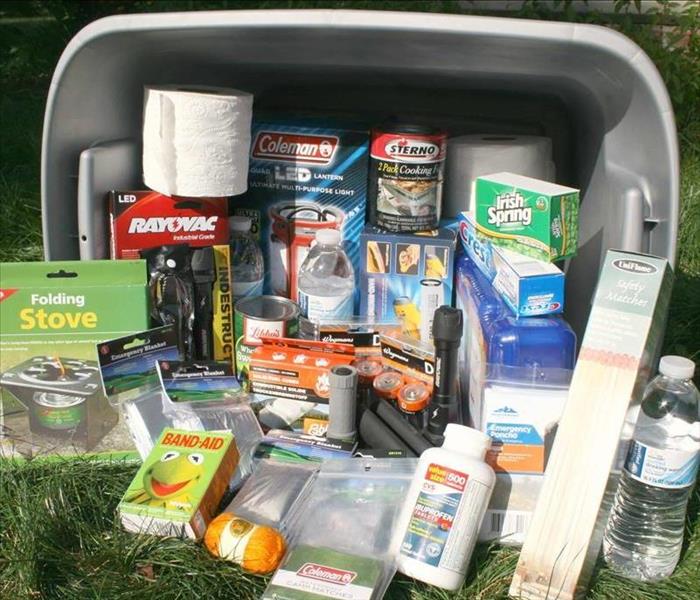 Prepared Kit Ready to Go!
Prepared Kit Ready to Go!
September is recognized as National Preparedness Month to remind everyone that “we must all take action, now and throughout the year, for the types of emergencies that could affect us where we live, work, and also where we visit.”
What you can do:
- Make A Family Plan – you may not be together with your family during a disaster.
- Set up emergency alerts from local officials
- Discuss family plans for disasters and plan where to go for safety.
- Collect information on paper including, phone numbers, emails, social media, medical facilities, doctors, service providers, school
- Decide on safe, familiar places where your family can go for protection and if you have pets think about animal-friendly locations
- Take Action – ensure you can go for at least 3 days without electricity, water service, access to supermarket, or other local services
- Prepare a disaster supply kit (water, food, battery-powered radio, flashlight, first aid kit, whistle, local maps)
- Bookmark weather.gov to stay informed on severe weather
- Learn about wireless emergency alerts, messages that will be sent to your phone during an emergency
Consider the following disasters that can occur at any time: Learn more about hazards which can affect your community and ways you can take action to prepare.
- Earthquakes – can occur suddenly and be deadly. Most earthquake-related casualties result from collapsing walls, flying glass, and falling objects.
- Floods - Flooding is the most common natural disaster in the United States and can happen anywhere.
- Hurricanes - have the power to cause widespread devastation, and can affect both coastal and inland areas.
- Tornadoes - are one of nature’s most violent storms, and can cause death, injury, and destruction within seconds.
- Wildfires - can occur anywhere and can destroy homes, businesses, infrastructure, natural resources, and agriculture.
When a Storm Hits, SERVPRO is Ready!
5/28/2019 (Permalink)
SERVPRO of Clovis specializes in storm and flood damage restoration. Our crews are highly trained and we use specialized equipment to restore your property to its pre-storm condition.
Faster Response
Since we are locally owned and operated, we are able to respond quicker with the right resources, which is extremely important. A fast response lessens the damage, limits further damage, and reduces the restoration cost.
Resources to Handle Floods and Storms
When storms hit Clovis, we can scale our resources to handle a large storm or flooding disaster. We can access equipment and personnel from a network of 1,650 Franchises across the country and elite Disaster Recovery Teams that are strategically located throughout the United States.
Have Storm or Flood Damage? Call Us Today (559) 297-3429
Preventing Water Damage From Rain
5/28/2019 (Permalink)
 Flooded Rain Water
Flooded Rain Water
Everyone loves the occasional summer thunderstorm - but it could cause major problems if rain water seeps into your home. One of the most common sources of water damage in a home is from rain water. It can enter through leaks in your roof, seeping in from the foundation, or even flooding into your basement. It is important to take the necessary steps to prevent water damage in your home such as:
Checking for proper drainage:
- Inspect your roof thoroughly for structural damage or holes
- Clear your gutters from leaves and other debris that could block the flow of water from draining into the yard
Install or Check Sump Pumps:
- Sump pump is very effective for keeping rainwater out of your house
- Have a professional check your sump pump to insure it is working properly once a year
Check sealant inside and outside foundation:
- Make sure the tar sealant covering the inner and outer sides of the foundation are intact
Inspect the slope of your lawn:
- Grading is the slope of your lawn and it should always slope away from your home to redirect the rainwater from flooding around the foundations
When you are dealing with storm, flood, and water damage, immediate action is crucial. You should choose the company with storm damage experience and expertise that has the resources and equipment to handle the job. SERVPRO of Clovis can respond immediately to storm and flooding conditions.





 24/7 Emergency Service
24/7 Emergency Service







